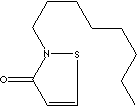PRODUCT IDENTIFICATION
26530-20-1

H.S. CODE
TOXICITY
LD50 Oral - rat - 550 mg/kg
2,3-Octylisothiazolone; 2-Octyl-4-isothiazolin-3-one;
Octhilinone; 2-Octyl-3(2H)-isothiazolone; 2-n-Octyl-4-isothiazolin-3-one; Kathon 893; Kathon LM; 2-Octyl-2H-isothiazol-3-one; 2-Octyl-3-isothiazolone; 2-n-Octyl-4-isothiazolin-3-one; Other RN: 122667-23-6, 12673-72-2, 245125-70-6, 249757-59-3, 53028-82-3, 68480-30-8 (hydrochloride);
CLASSIFICATION
Disinfectant, Thiazoline, Fungicide, Bactericide, Preservative
EXTRA NOTES
EPA Pesticide Chemical Code 099901
PHYSICAL AND CHEMICAL PROPERTIES
120 C
Insoluble
NFPA RATINGS
Health hazard: 3, Fire: 0, Reactivity Hazard: 0
REFRACTIVE INDEX
Stable under ordinary conditions. Light sensitive
EXTERNAL LINKS & GENERAL DESCRIPTION
http://apps.kemi.se/
Octylisothiazolinone
is also used almost exclusively as a preservative in latex paints,
but a small proportion is also used as a preservative in the leather
and fur industries. Isothiazolines are also used as slime control
agents in the pulp industry and as wood impregnating agents. Low
concentrations, mostly <<0.01 %, of isothiazolines are present
in a large number of products, which means that the volumes reported
are averages with a wide interval. Concentrations are often given
as maximum values, which compounds the uncertainty regarding these
volumes.
Local:
Isothiazolinones containing sulfur atom (S), nitrogen (N), oxygen (O) at 3
position and hydrogen (H) can find application for making broad-spectrum biocides and
preservatives such as antiseptic agents, bactericides, slimicides, and
fungicides. The biggest application is
in paint industry especially marine antifouling agent. They are also used in
adhesives, cutting oils, water systems, cosmetics, household goods and wound
protectant for pruning cuts. They are also used as pulp and wood impregnating agents
as well as in leather, fur and polymer process.
It is known to cause allergy and chemical burn if high
concentration is used in personal care products and cosmetics.
The list of isothiazolinones include;
|
Material |
CAS # |
EINECS # |
| (4-Chlorobenzyl)-3(2H)-isothiazolone | 26530-09-6 |
|
| 1,2-Benzisothiazolin-3-one | 2634-33-5 | 220-120-9 |
| 2-Butyl-1,2-benzisothiazolin-3-one | 4299-07-4 |
|
| 2-Methyl-4,5-trimethylene-4-isothiazolin-3-one | 82633-79-2 |
|
| 2-Methyl-4-isothiazolin-3-one | 2682-20-4 | 220-239-6 |
| 2-Methyl-3-isothiazolone hydrochloride | 26172-54-3 |
247-499-3 |
| 2-Octyl-3(2H)-isothiazolone | 26530-20-1 | 247-761-7 |
| 4,5-Dichloro-2-cyclohexyl-4-isothiazolin-3-one | 57063-29-3 |
|
| 4,5-Dichloro-2-octyl-3(2H)-isothiazolone | 64359-81-5 | 264-843-8 |
| 4-Chloro-2-octyl-3(2H)-isothiazolone | 64359-80-4 | 264-842-2 |
| 5-Chloro-2-(4-chlorophenylmethyl)-3(2H)-isothiazolone | 66159-95-3 |
|
| 5-Chloro-2-methyl-4-isothiazolin-3-one | 26172-55-4 | 247-500-7 |
| 5-Chloro-2-methyl-3(2H)-isothiazolone, calcium chloride complex | 57373-19-0 |
|
5-Chloro-2-methyl-2H-isothiazol-3-one hydrochloride |
26530-03-0 |
247-760-1 |
| 2-Methyl-4-isothiazolin-3-one calcium chloride | 57373-20-3 |
|
Mixtures of these materials |
|
|
Common biocides ( antiseptic agents, preservatives, bactericides, slimicides, fungicides) in cosmetics are parabens, isothiazolones, formaldehyde and formaldehyde releasing substances such as quaternium 15, diazolidinyl urea.
GENERAL DESCRIPTION OF ANTISEPTIC AGENT: Antiseptic agent is a substance which kills or inhibits the growth of disease-causing bacteria and other microorganisms. It is essentially nontoxic to to be applied to the skin or mucous membranes. (Disinfectant including cresol, bleaching powder, and phenol is in general toxic to cells of the body). Common antiseptic agents are Benzalkonium Chloride, Cetrimide, Chlorhexidine, Hexachlorophene, Iodine Compounds, Mercury Compounds (Thimerosol), Alcohol and Hydrogen Peroxide, Hexamine Hippurate, Triclosan, Cetylpyridinium Chloride, And Dequalinium. Other substances which can be used for antiseptic purpose include Boric acid and volatile oils such as Methyl Salicylate.Hexachlorophene and Benzalkonium Chloride are used primarily in hand or face washes. Benzalkonium Chloride must not be applied to areas which have not been fully rinsed as it is inactivated by organic compounds. Benzalkonium application many include disinfecting instruments and preservativing drugs in low concentration form.
Iodine compounds have the widest spectrum of antiinfectives against bacteria, fungi, spores, protozoa, viruses, and yeasts. Aqueous iodine are less effective than alcoholic solutions, but alcoholic component is drying and irritating to abraided skin. Povidone iodine is convenient to use as it is less irritating, but not as effective.
Chlorhexidine is used as a safe antiseptic or disinfectant to apply to prevent body infection and in oral rinses for treating sore gums and mouth ulcers and preventing plaque on teeth. It is used in the form of acetate, gluconate or hydrochloride, either alone or in combination with others such as cetrimide.
Cetrimide is an antiseptic agent with detergent properties. It has the wide spectrum of antiinfectives against bacteria and fungi. It is used as an ingredient of shampoos for treating seborrhoea and psoriasis. A very dilute solution can be applied topically for the relief of sore gums.
Hippuric Acid, an amino acid glycine, is excreted from the body and is used in urinary system drugs. Hexamine hippurates is helpful for preventing and treating infections of the urinary system; it acts by being transformed to formaldehyde.
Triclosan is a very popular antibacterial agent. It is used in hospitals for cleansing and disinfecting the skin of patients and surgeons. It is used in cosmetics, household goods and personal care products. It is also used in plastics and textiles for antibacterial activity purpose.
Cetylpyridinium chloride is used in oral rinses for cleaning mouth and treating minor throat or mouth infections and teething problems.
Dequalinium chloride is antiinfectives against bacteria and fungi. It is used in treating bacterial or fungal infections of mouth and throat.
APPEARANCE
ASSAY
40% in propyleneglycol
PRICE
INFORMATION